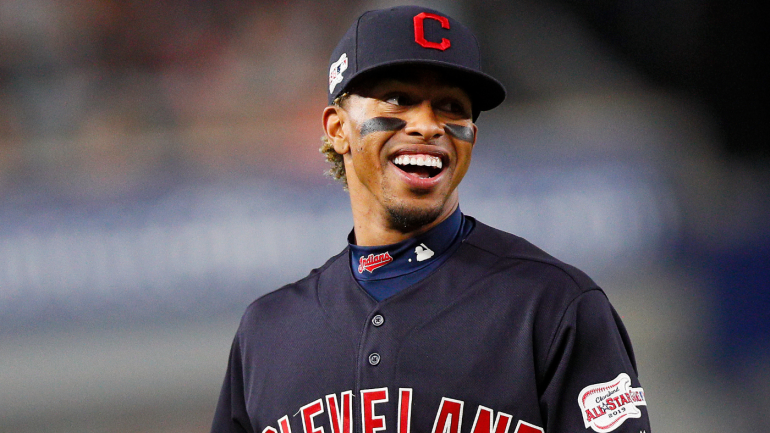
The San Diego Padres made a pair of headline-grabbing trades this week. First netting Blake Snell from the Tampa Bay Rays, and then adding Yu Darvish in a swap with the Chicago Cubs. General manager A.J. Preller's wheelin' and dealin' provided an otherwise dull winter with a jolt of excitement. With any luck, more activity will follow.
Presuming that proves to be the case, one important piece of business likely to be resolved by Opening Day involves Cleveland shortstop Francisco Lindor. The owner of the Fighting Franconas has all but conceded he's unwilling to pay Lindor his worth, as he's more concerned with his profits than his team's chances of winning a pennant. As a result, the onus is now on Cleveland's front office to find the best possible trade for Lindor this winter, lest they risk him walking at year's end for a trifling draft pick.
Though Lindor's situation may appear distinct and separate from the Padres' trades, we believe that San Diego's deals provide a glimpse at the trade market. With that in mind, let's outline three things you're likely to see as part of a Lindor trade, whenever it goes down.
1. No elite prospects
It used to be that a star player would net high-grade prospects, even if said star had only one year remaining on their contract. That's no longer the case. Teams have fetishized service time, surplus value, and financial flexibility to the extent that you oftentimes have a better chance of extracting a dragon's tooth than acquiring an elite prospect. (For the sake of defining terms, "elite" in this article means a top-10 overall prospect.)
The Lindor trade probably won't prove to be the exception -- not when everyone knows Cleveland won't pony up to keep him around, reducing the team's leverage. The Snell and Darvish trades sure weren't exceptions, either, with one scout estimating to CBS Sports that the Padres surrendered maybe just two of the organization's top 10 prospects.
Obviously the quality of the prospect matters more than where they rank within their current organization, but Cleveland fans would be wise to adjust their expectations by looking further down prospect lists when they start building fantasy trades. That doesn't mean Cleveland can't get a good player in the long run (Michael Brantley, Corey Kluber, and Mike Clevinger were non-elite prospects who Cleveland helped turn into All-Star players), just that the headliner seems unlikely to overwhelm on the day of the trade.
2. Portfolio return
You can bet the farm on Cleveland receiving multiple players in exchange for Lindor. That isn't what we mean by "portfolio return"; rather, we mean an intentional targeting of players with various risk factors and arrival dates, including, likely, a player or two who has already broken into the Show.
The Rays, who often operate in a manner similar to their small-market peers, obtained a "portfolio return" in their Snell trade. They received one player with substantive big-league service time (Francisco Mejia), one with some big-league exposure (Luis Patino), one with a few seasons' worth of professional experience (Blake Hunt), and one who hasn't yet played professionally because of the pandemic (Cole Wilcox).
Cleveland has followed this blueprint in most of its recent big trades, too. Sending Mike Clevinger to San Diego, for example, netted Cleveland six players: three had major-league service time and could slot right in on the roster; one had achieved success in Double-A; and two had yet to play above A-ball. When Cleveland traded Trevor Bauer as part of a three-team swap, it landed five players: one with substantive big-league service time; two with some; one who hadn't pitched above Double-A; and one other who hadn't escaped complex ball. You get the gist.
That kind of intentional spreading can help a team with future roster-planning in more ways than one. Teams always have to be mindful about the Rule 5 Draft and minor-league free agency, and it often behooves them to not have their talent arriving in one or two clusters. A portfolio approach also enables a team to play the odds, and to get a combination of low-risk, medium-reward and high-risk, high-reward players in return.
In Cleveland's case, most of its top prospects are stationed in the low minors. It stands to reason, then, that they might prioritize adding players further along in their development -- that way, they can bridge between the cores of yesterday, today, and tomorrow.
3. Big-league help
As noted above, it's probably fair to expect Cleveland to net at least one player in a Lindor trade who has already graced a big-league field. Of course, that doesn't mean the player is going to be a star-caliber contributor -- it's more likely to be a complementary player with three-plus years of team control remaining -- but the player in question could help Cleveland remain somewhat competitive in the season to come.
As counterintuitive as that sounds -- if Cleveland wants to win in 2021, then why would it trade Lindor to begin with? -- the Fighting Franconas' front office deserves credit for resisting the urge to pull the plug entirely as a means of overcoming ownership's self-imposed financial restraints. Dating back to 2013, the only team to win more games than Cleveland has been the Los Angeles Dodgers.
Part of that is because Cleveland plays in a fairly weak division, but part of that is because the organization excels at talent evaluation and at player development. Cleveland fans can only hope that the upcoming Lindor trade will provide the latest instance of those traits at work. Otherwise, the franchise is highly unlikely to remain near the top of the next decade's wins leaderboard.
"trade" - Google News
December 30, 2020 at 10:53PM
https://ift.tt/3o2sx7Q
What will a Francisco Lindor trade look like? Expect these three elements in deflated market - CBS sports.com
"trade" - Google News
https://ift.tt/2VQiPtJ
Tidak ada komentar:
Posting Komentar